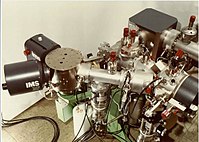
Photo from wikipedia
GC-MS usually employs a 70 eV electron ionization (EI) ion source, which provides mass spectra with detailed fragment ion information that are amenable for library search and identification with names… Click to show full abstract
GC-MS usually employs a 70 eV electron ionization (EI) ion source, which provides mass spectra with detailed fragment ion information that are amenable for library search and identification with names and structures at the isomer level. However, conventional EI often suffers from low intensity or the absence of molecular ions, which reduces detection and identification capabilities in analyses. In an attempt to enhance the molecular ions, several softer ion sources are being used to supplement standard EI, including chemical ionization (CI), atmospheric pressure chemical ionization (APCI), field ionization (FI), photoionization (PI), and low electron energy EI. However, the most advantageous way to enhance molecular ions is to use cold EI, which employs 70 eV EI of cold molecules in supersonic molecular beams. Cold EI yields classical EI mass spectra with highly enhanced molecular ions, which still provides high detectability and library-searchable mass spectra. In this paper, we explain and discuss why cold EI is not a supplementary ion source to standard EI, but rather it is a highly superior replacement to standard EI. With cold EI, there is no need for standard EI or any other supplemental ion source. We describe 16 benefits and unique features of cold EI that not only yield better results for existing applications but also significantly extend the range of compounds and applications amenable for GC-MS analysis.
Journal Title: Journal of the American Society for Mass Spectrometry
Year Published: 2021
Link to full text (if available)
Share on Social Media: Sign Up to like & get
recommendations!